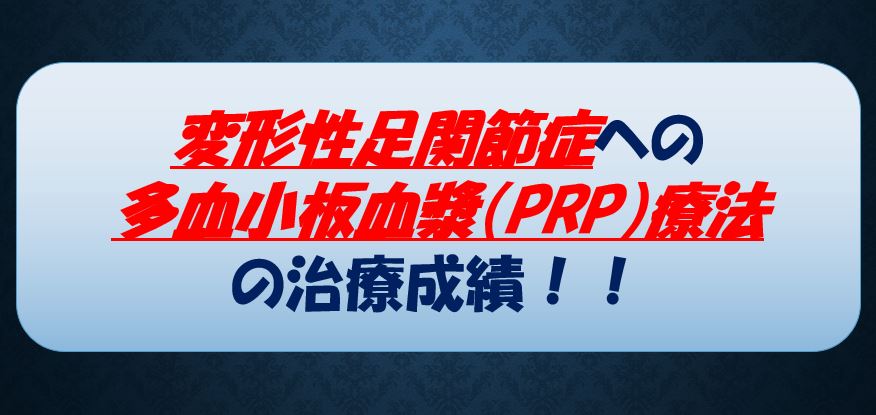こんにちは!
運動器専門のリハビリスタッフです!!
いつもお世話になります。
今回は、『変形性足関節症(足関節OA)への多血小板血漿(PRP)療法の治療成績』について解説させていただきます。
変形性足関節症は足関節の骨折や捻挫などの外傷をきっかけとして発症することがあるとされています。
症状としては足関節の疼痛や腫脹、足関節可動域制限をきたすことがあります。
変形性足関節症は一次性と二次性に分けられます
一次性:明らかな外傷の既往がないもの
二次性:何らかの原因を有する(外傷や他の疾患など)
日本では二次性が多いとされている。
そんな中、2021年に、変形性足関節症に対して多血小板血漿(PRP:platelet-rich plasma)療法の効果があるのかを検証した論文が海外で報告されております。
この論文の検証結果がとても気になるところです。
◆PRP療法とは
PRP療法とは自分の血液を採取して、特殊な技術を駆使し、血液中の血小板が多く含まれる部分のみを抽出して、PRP(多血小板血漿)を作成します。
そして、自分の傷んでいる部位に注射することで早期治癒を図ります。
早期の競技復帰のために、PRP療法を行っているプロスポーツ選手なども多くいらっしゃいます。
ヨーロッパやアメリカでは、自己治癒力をサポートする治療として頻繁に行われているようです。
現時点(2022年3月)で多血小板血漿(PRP)療法は自費診療ですので、少し治療費は高くなります。
◆論文紹介
Randomized Controlled Trial
JAMA (IF: 56.27; Q1)
. 2021 Oct 26;326(16):1595-1605.
doi: 10.1001/jama.2021.16602.
Effect of Platelet-Rich Plasma Injections vs Placebo on Ankle Symptoms and Function in Patients With Ankle Osteoarthritis: A Randomized Clinical Trial
足関節変形性関節症患者の足関節の症状と機能に対する多血小板血漿(PRP)注射とプラセボの効果。無作為化臨床試験
Liam D A Paget 1 2 3, Gustaaf Reurink 1 2 3 4, Robert-Jan de Vos 5, Adam Weir 5 6 7, Maarten H Moen 4 8, Sita M A Bierma-Zeinstra 5 9, Sjoerd A S Stufkens 1 2 3, Gino M M J Kerkhoffs 1 2 3, Johannes L Tol 2 3 10, PRIMA Study Group
Collaborators, Affiliations expand
- PMID: 34698782 PMCID: PMC8548954 (available on 2022-04-26)
Abstract
Importance: Approximately 3.4% of adults have ankle (tibiotalar) osteoarthritis and, among younger patients, ankle osteoarthritis is more common than knee and hip osteoarthritis. Few effective nonsurgical interventions exist, but platelet-rich plasma (PRP) injections are widely used, with some evidence of efficacy in knee osteoarthritis.
概要
重要性 成人の約3.4%が変形性足関節症であり、若年層では膝や股関節よりも足首の変形性足関節症が多い。手術以外の有効な介入方法はほとんど存在しないが、多血小板血漿(PRP)注射は広く使用されており、変形性膝関節症における有効性を示すエビデンスもある。
Objective: To determine the effect of PRP injections on symptoms and function in patients with ankle osteoarthritis.
目的 変形性足関節症患者におけるPRP注射の症状および機能に対する効果を明らかにすること。
Design, setting, and participants: A multicenter, block-randomized, double-blinded, placebo-controlled clinical trial performed at 6 sites in the Netherlands that included 100 patients with pain greater than 40 on a visual analog scale (range, 0-100) and tibiotalar joint space narrowing. Enrollment began on August 24, 2018, and follow-up was completed on December 3, 2020.
デザイン、設定、参加者 オランダの6施設で行われた、visual analog scaleで40以上の痛み(範囲:0~100)および距腿関節腔狭窄を有する患者100人を含む多施設ブロック無作為化二重盲検プラセボ対照臨床試験。2018年8月24日に登録を開始し、2020年12月3日にフォローアップを完了しました。
Interventions: Patients were randomly assigned (1:1) to receive 2 ultrasonography-guided intra-articular injections of either PRP (n = 48) or placebo (saline; n = 52).
介入。患者を、PRP(n=48)またはプラセボ(生理食塩水:n=52)のいずれかの超音波ガイド下関節内注射を2回受ける群に無作為に割り付けた(1:1)。
Main outcomes and measures: The primary outcome was the validated American Orthopaedic Foot and Ankle Society score (range, 0-100; higher scores indicate less pain and better function; minimal clinically important difference, 12 points) over 26 weeks.
主なアウトカムと測定法 主要アウトカムは、26週間にわたる有効なAmerican Orthopaedic Foot and Ankle Society score(範囲:0~100、スコアが高いほど痛みが少なく機能が優れていることを示す、臨床的に重要な最小差:12ポイント)であった。
Results: Among 100 randomized patients (mean age, 56 years; 45 [45%] women), no patients were lost to follow-up for the primary outcome. Compared with baseline values, the mean American Orthopaedic Foot and Ankle Society score improved by 10 points in the PRP group (from 63 to 73 points [95% CI, 6-14]; P < .001) and 11 points in the placebo group (from 64 to 75 points [95% CI, 7-15]; P < .001). The adjusted between-group difference over 26 weeks was -1 ([95% CI, -6 to 3]; P = .56). One serious adverse event was reported in the placebo group, which was unrelated to the intervention; there were 13 other adverse events in the PRP group and 8 in the placebo group.
結果 無作為化された100人の患者(平均年齢56歳;45人[45%]女性)のうち、主要アウトカムでフォローアップを失った患者はいなかった。ベースライン値と比較して、American Orthopaedic Foot and Ankle Society scoreの平均値は、PRP群で10ポイント(63から73ポイント[95%CI、6~14])、プラセボ群で11ポイント(64から75ポイント[95%CI、7~15]、P < .001)改善された。26 週間にわたる調整後の群間差は,-1([95% CI,-6~3];P = 0.56)であった.重篤な有害事象はプラセボ群で1件報告されたが、介入とは無関係であった;その他の有害事象は、PRP群で13件、プラセボ群で8件であった。
◆論文の結論
Conclusions and relevance: Among patients with ankle osteoarthritis, intra-articular PRP injections, compared with placebo injections, did not significantly improve ankle symptoms and function over 26 weeks. The results of this study do not support the use of PRP injections for ankle osteoarthritis.
結論と妥当性 変形性足関節症患者において、関節内PRP注射は、プラセボ注射と比較して、26週間にわたり足関節の症状および機能を有意に改善しなかった。本試験の結果は、変形性足関節症に対するPRP注射の使用を支持するものではありません。
◆まとめ
上記論文ではオランダの6施設で、100名の変形性足関節症患者(VAS40mm以上)に対して、PRP(多血小板血漿)療法群48名とプラセボ(生理食塩水)群52名の2群に振り分けて効果を検証しております。
評価は26週にわたってAmerican Orthopaedic Foot and Ankle Society scoreにて実施しております。
結果はPRP(多血小板血漿)療法群もプラセボ群も改善はみられていますが、2群間での有意差はありませんでした。
よって、上記論文の結果から考えると、多血小板血漿(PRP)療法は、様々な外傷や障害に適応されていますが、変形性足関節症においては、効果は乏しいようです。
今回は、『変形性足関節症(足関節OA)への多血小板血漿(PRP)療法の治療成績』について解説させていただきました。



